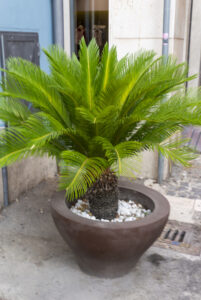There are over 2,500 types of palm trees, with many being subtropical or tropical in origin. Besides their role as yard trees in warm climates, indoor palm trees are excellent as desktop plants.
You can tell the difference between most palms by their massive green leaves, called fronds, sitting on the crown of an unbranched stem.
Most people consider palm trees as just tropical plants. Provide palms with lots of water, sun, and everything will be alright. However, some species will drown if overwatered. Some palm tree types can’t live without fertilizer. Meticulously researching the specific palm tree type is vital to successful growth.
Growing Indoor Palm Trees
Palm trees are a collection of plants, including hundreds of types that have diverse needs.
Some are understory plants that enjoy dark, wet atmospheres. Some palms might necessitate fertilizer, and some might not. A good rule of thumb, if you desire healthy palms, be sure to feed your trees. This suggestion is valid for indoors as well as outdoor palms.
The best way to flaunt your palm is contingent on its growth habit and size. They’re great as lobby plants and corner-specimen trees. Also, palms do excellently in groups with little potted plants gathered at their base. Wherever you put your palm, don’t put it in a spot with many people and things brushing against it regularly. Too much contact weakens the palm and perhaps kill the frond.
If you take excellent care of your palm, based on the types, there’s a chance that the leaves might be brushing against your ceiling after a couple of years. Regrettably, you could never top-trim a palm tree. All palms develop from a center tip. If you eliminate the growing tip, the plant will perish.
So, if you have a practically mature palm erupting from your home, good for you. The next step is to find a nearby commercial property (business office, school, church, or hotel) that could use a tremendous indoor palm plant.
Light
One of the reasons palms are such well-liked houseplants is that they can effortlessly adapt to indoor, low-light settings. Most palms desire the shade. These plants will suffer if put into direct sunlight.
Palm houseplants favor bright indirect light but will endure less light, particularly in the wintertime. Palms won’t live if there isn’t any natural light in the room. If there isn’t any natural light, the palm will need a grow light. For instance, the kentia palm hates the direct sun but love the partial shade. Others, like the Mexican fan palm tree, tolerate way more sunlight.
Soil
The best soil for potted palm trees is a porous mix of shredded bark, peat moss, and leaf mold. Also, you can purchase palm soil mix specifically for flourishing palm plants. Otherwise, palm trees will thrive excellently using an all-purpose potting soil. If you have a habit of forgetting to water your plants, you can put peat moss into some all-purpose potting soil to help your palm trees keep their moisture.
For more information on growing indoor palm trees, reach out to us at Mechanicsburg Tree Service.


Recent Comments